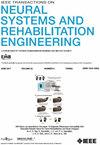Development of a Wearable Sleeve-Based System Combining Polymer Optical Fiber Sensors and an LSTM Network for Estimating Knee Kinematics
IF 4.8
2区 医学
Q2 ENGINEERING, BIOMEDICAL
IEEE Transactions on Neural Systems and Rehabilitation Engineering
Pub Date : 2025-02-10
DOI:10.1109/TNSRE.2025.3540708
引用次数: 0
Abstract
This study presents a novel wearable solution integrating Polymer Optical Fiber (POF) sensors into a knee sleeve to monitor knee flexion/extension (F/E) patterns during walking. POF sensors offer advantages such as flexibility, light weight, and robustness to electromagnetic interference, making them ideal for wearable applications. However, when one integrates these sensors into a knee sleeve, they exhibit non-linearities, including hysteresis and mode coupling, which complicate signal interpretation. To address this issue, a Long Short-Term Memory (LSTM) network was implemented to model temporal dependencies in sensor output, hence providing accurate knee angle estimates. Data were collected from 31 participants walking at different speeds on a treadmill, using a camera-based motion capture system for validation. Configurations with multiple (up to five) sensors were considered. The best performance was achieved using three sensors, yielding a median root mean square error (RMSE) of 3.41° (interquartile range: 2.50° –求助全文
约1分钟内获得全文
求助全文
来源期刊
CiteScore
8.60
自引率
8.20%
发文量
479
审稿时长
6-12 weeks
期刊介绍:
Rehabilitative and neural aspects of biomedical engineering, including functional electrical stimulation, acoustic dynamics, human performance measurement and analysis, nerve stimulation, electromyography, motor control and stimulation; and hardware and software applications for rehabilitation engineering and assistive devices.

 求助内容:
求助内容: 应助结果提醒方式:
应助结果提醒方式:


